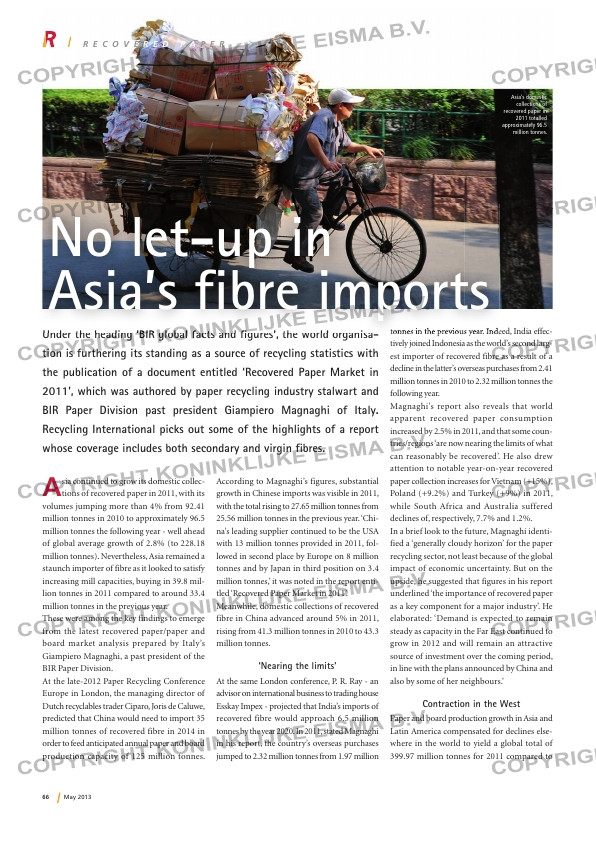Page 66 from: May 2013

66 May 2013
Asia continued to grow its domestic collec-tions of recovered paper in 2011, with its
volumes jumping more than 4% from 92.41
million tonnes in 2010 to approximately 96.5
million tonnes the following year – well ahead
of global average growth of 2.8% (to 228.18
million tonnes). Nevertheless, Asia remained a
staunch importer of fibre as it looked to satisfy
increasing mill capacities, buying in 39.8 mil-
lion tonnes in 2011 compared to around 33.4
million tonnes in the previous year.
These were among the key findings to emerge
from the latest recovered paper/paper and
board market analysis prepared by Italy’s
Giampiero Magnaghi, a past president of the
BIR Paper Division.
At the late-2012 Paper Recycling Conference
Europe in London, the managing director of
Dutch recyclables trader Ciparo, Joris de Caluwe,
predicted that China would need to import 35
million tonnes of recovered fibre in 2014 in
order to feed anticipated annual paper and board
production capacity of 125 million tonnes.
According to Magnaghi’s figures, substantial
growth in Chinese imports was visible in 2011,
with the total rising to 27.65 million tonnes from
25.56 million tonnes in the previous year. ‘Chi-
na’s leading supplier continued to be the USA
with 13 million tonnes provided in 2011, fol-
lowed in second place by Europe on 8 million
tonnes and by Japan in third position on 3.4
million tonnes,’ it was noted in the report enti-
tled ‘Recovered Paper Market in 2011’.
Meanwhile, domestic collections of recovered
fibre in China advanced around 5% in 2011,
rising from 41.3 million tonnes in 2010 to 43.3
million tonnes.
‘Nearing the limits’
At the same London conference, P. R. Ray – an
advisor on international business to trading house
Esskay Impex – projected that India’s imports of
recovered fibre would approach 6.5 million
tonnes by the year 2020. In 2011, stated Magnaghi
in his report, the country’s overseas purchases
jumped to 2.32 million tonnes from 1.97 million
tonnes in the previous year. Indeed, India effec-
tively joined Indonesia as the world’s second larg-
est importer of recovered fibre as a result of a
decline in the latter’s overseas purchases from 2.41
million tonnes in 2010 to 2.32 million tonnes the
following year.
Magnaghi’s report also reveals that world
apparent recovered paper consumption
increased by 2.5% in 2011, and that some coun-
tries/regions ‘are now nearing the limits of what
can reasonably be recovered’. He also drew
attention to notable year-on-year recovered
paper collection increases for Vietnam (+15%),
Poland (+9.2%) and Turkey (+9%) in 2011,
while South Africa and Australia suffered
declines of, respectively, 7.7% and 1.2%.
In a brief look to the future, Magnaghi identi-
fied a ‘generally cloudy horizon’ for the paper
recycling sector, not least because of the global
impact of economic uncertainty. But on the
upside, he suggested that figures in his report
underlined ‘the importance of recovered paper
as a key component for a major industry’. He
elaborated: ‘Demand is expected to remain
steady as capacity in the Far East continued to
grow in 2012 and will remain an attractive
source of investment over the coming period,
in line with the plans announced by China and
also by some of her neighbours.’
Contraction in the West
Paper and board production growth in Asia and
Latin America compensated for declines else-
where in the world to yield a global total of
399.97 million tonnes for 2011 compared to
R E C O V E R E D P A P E R
Under the heading ‘BIR global facts and figures’, the world organisa-
tion is furthering its standing as a source of recycling statistics with
the publication of a document entitled ‘Recovered Paper Market in
2011’, which was authored by paper recycling industry stalwart and
BIR Paper Division past president Giampiero Magnaghi of Italy.
Recycling International picks out some of the highlights of a report
whose coverage includes both secondary and virgin fibres.
No let-up in
Asia’s fibre imports
Asia’s domestic
collections of
recovered paper in
2011 totalled
approximately 96.5
million tonnes.
RI-4_Recovered_paper.indd 66 03-05-13 14:30



